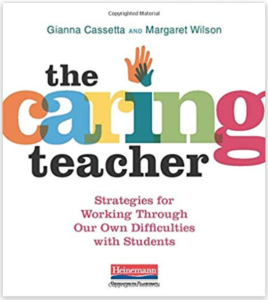Do You Have a Challenging Student? Read “The Caring Teacher”
Have you ever had a student you struggled to connect with? How you ever felt a twinge of guilt as you recognize that there are a couple of students in your class who are harder to like than others?
I know the lie we’re supposed to tell: we like all of our students just the same. But when I consider the above questions, a couple of students immediately come to mind. There was Mary, who routinely lied to me and other students–telling us stories we all knew were made up and defending them vigorously when challenged. I think of Alec, who seemed unable to hold back sexually explicit language as soon as I was out of earshot. And then there was Ally–unwashed, surly, and scowling, who verbally abused children and adults alike.
If we’re honest with ourselves, we all have students who we struggle with. And—and this is a big AND—when we struggle with connecting with those students, we diminish their chances of having social and academic success in school.
We all need help, and thanks to Gianna Cassetta and Margaret Wilson we have some! They have written a thoughtful and practical book that is compassionate of both children and teachers: The Caring Teacher: Strategies for Working Through Our Own Difficulties with Students.
 In this wonderful guide for teachers, they lay out straightforward and heartfelt suggestions to help teachers get better at working through emotional barriers that keep us from connecting with the kids who most need strong and positive relationships. They firmly guide us to explore our own baggage that needs examination and then point us to strategies we can use right away. I especially loved the organization of this book which moves back and forth from poignant narrative (both authors are highly experienced educators with tons of practical experience) to action steps offered in three categories: commitments, strategies, and shifts. Each of these action steps is accompanied by a brief description to guide teachers to successful implementation. Here were a few of these that I especially enjoyed:
In this wonderful guide for teachers, they lay out straightforward and heartfelt suggestions to help teachers get better at working through emotional barriers that keep us from connecting with the kids who most need strong and positive relationships. They firmly guide us to explore our own baggage that needs examination and then point us to strategies we can use right away. I especially loved the organization of this book which moves back and forth from poignant narrative (both authors are highly experienced educators with tons of practical experience) to action steps offered in three categories: commitments, strategies, and shifts. Each of these action steps is accompanied by a brief description to guide teachers to successful implementation. Here were a few of these that I especially enjoyed:
- Shift: Focus on Assets, Not Deficits
- Strategy: Assess Children’s Self-Perceived Agency
- Commitment: Examine Asset and Deficit Labeling
- Strategy: Use a Conversation Protocol
- Strategy: Invite a Trusted Colleague to Observe
There was a huge emphasis in the middle of this book on the effective use of language, and for those of you who are familiar with What We Say and How We Say It Matter, you’ll find wonderful resonance here.
In addition to being a fantastically practical resource, this book is also beautifully written. When I first opened the book, I was standing in the kitchen and meant to just glance at the first page. Ten minutes later, I decided I should go ahead and move to the couch, and before I knew it, I was several chapters in. I simply couldn’t put it down. Here’s an example of a passage I must have read five times—just to let the words play themselves out over and over: “Sometimes we think there are two options with children: forcing or ignoring. Imposing our will or throwing our hands up in despair. But autonomy exists in the choices in between, and so with Willy, I lingered there” (p. 46). I mean, come on—that’s great writing.
This is the book we’ve all been waiting for. Margaret and Gianna are caring, thoughtful, and respectful, but they also don’t hold back, so be ready to catch your breath as you come to a painful realization now and then. Their passion for teaching and commitment to children—all children, but especially those who have been dealt a tough hand—is unwavering. This should be required reading for all new teachers, and I hope it lands in teacher-led book study groups everywhere. It will help all of us find new compassion as well as new strategies and techniques to help challenging children find more success in school.




